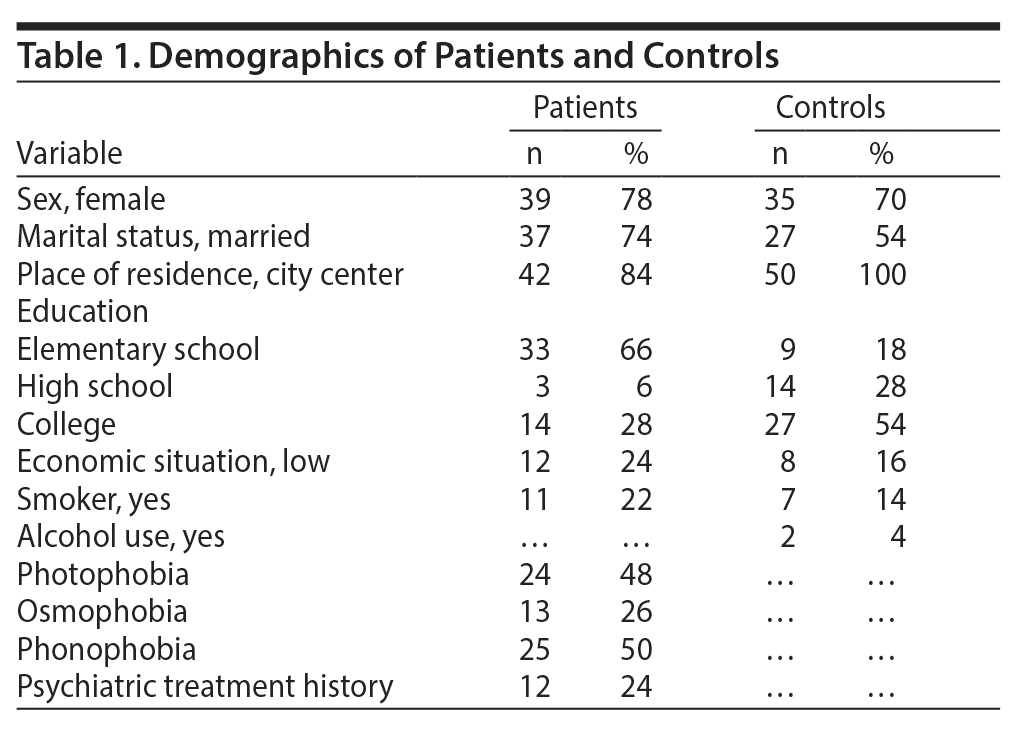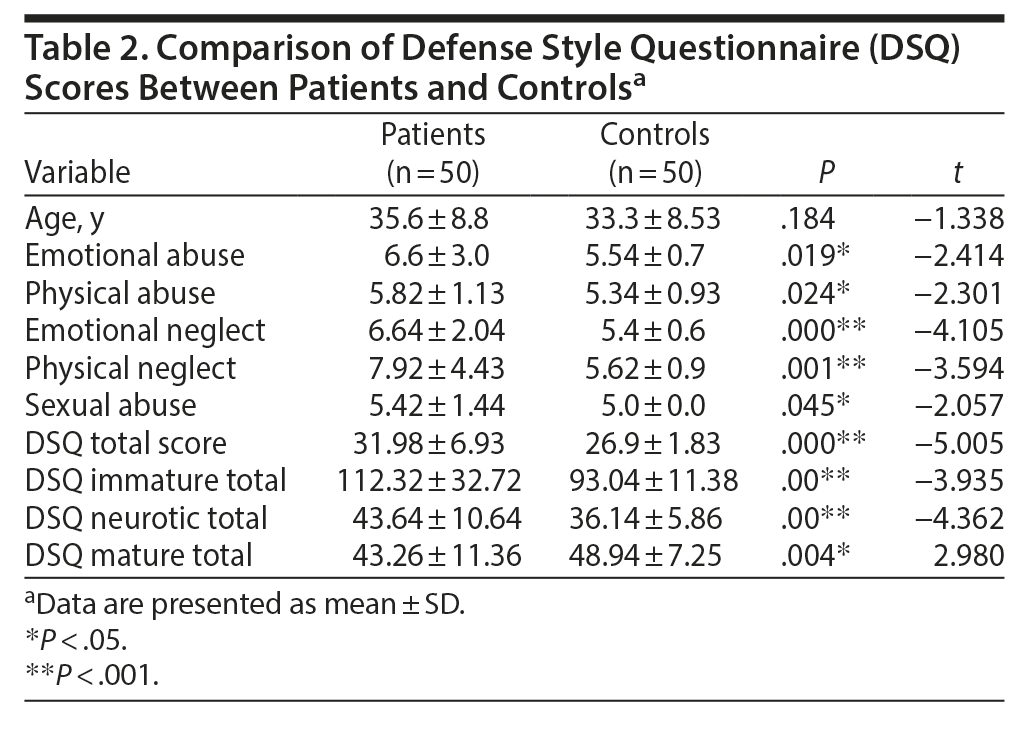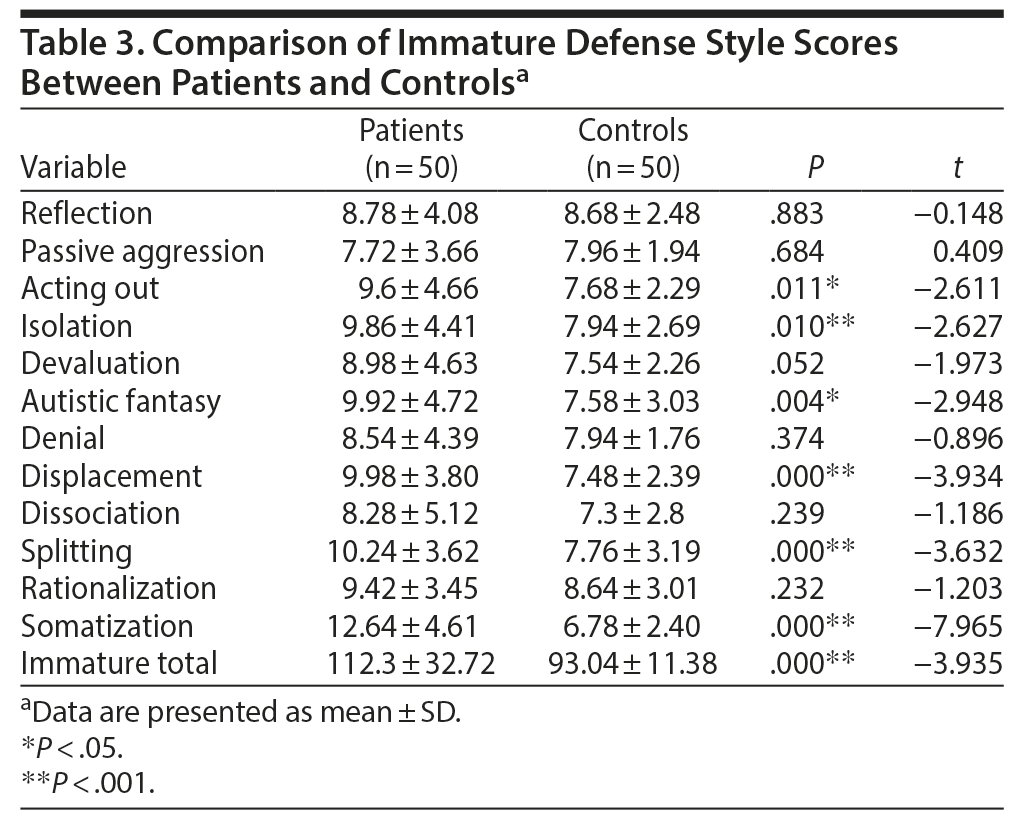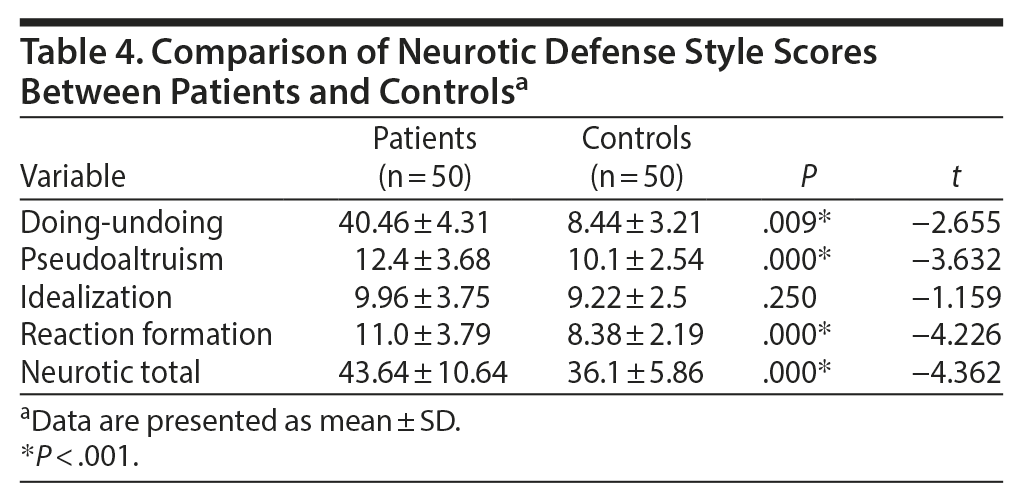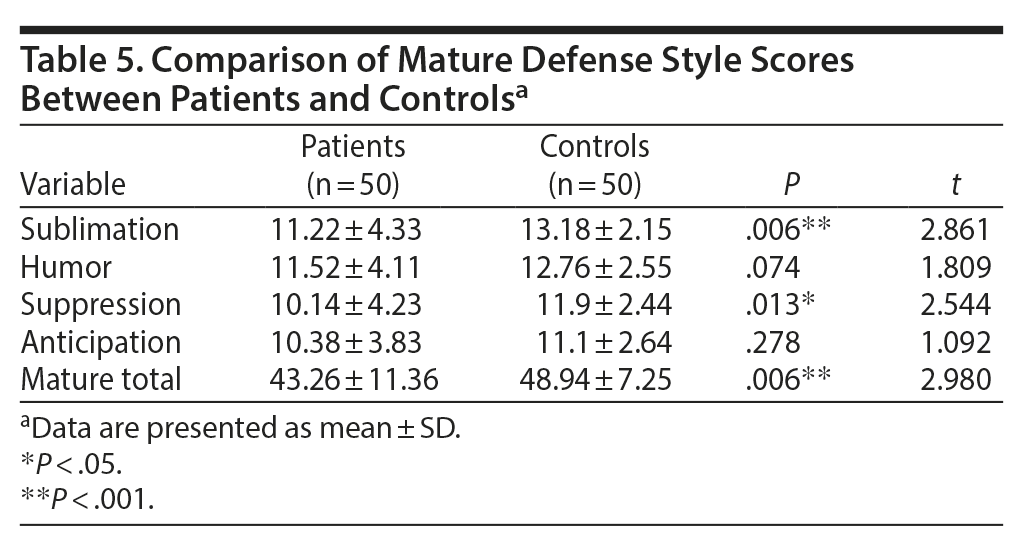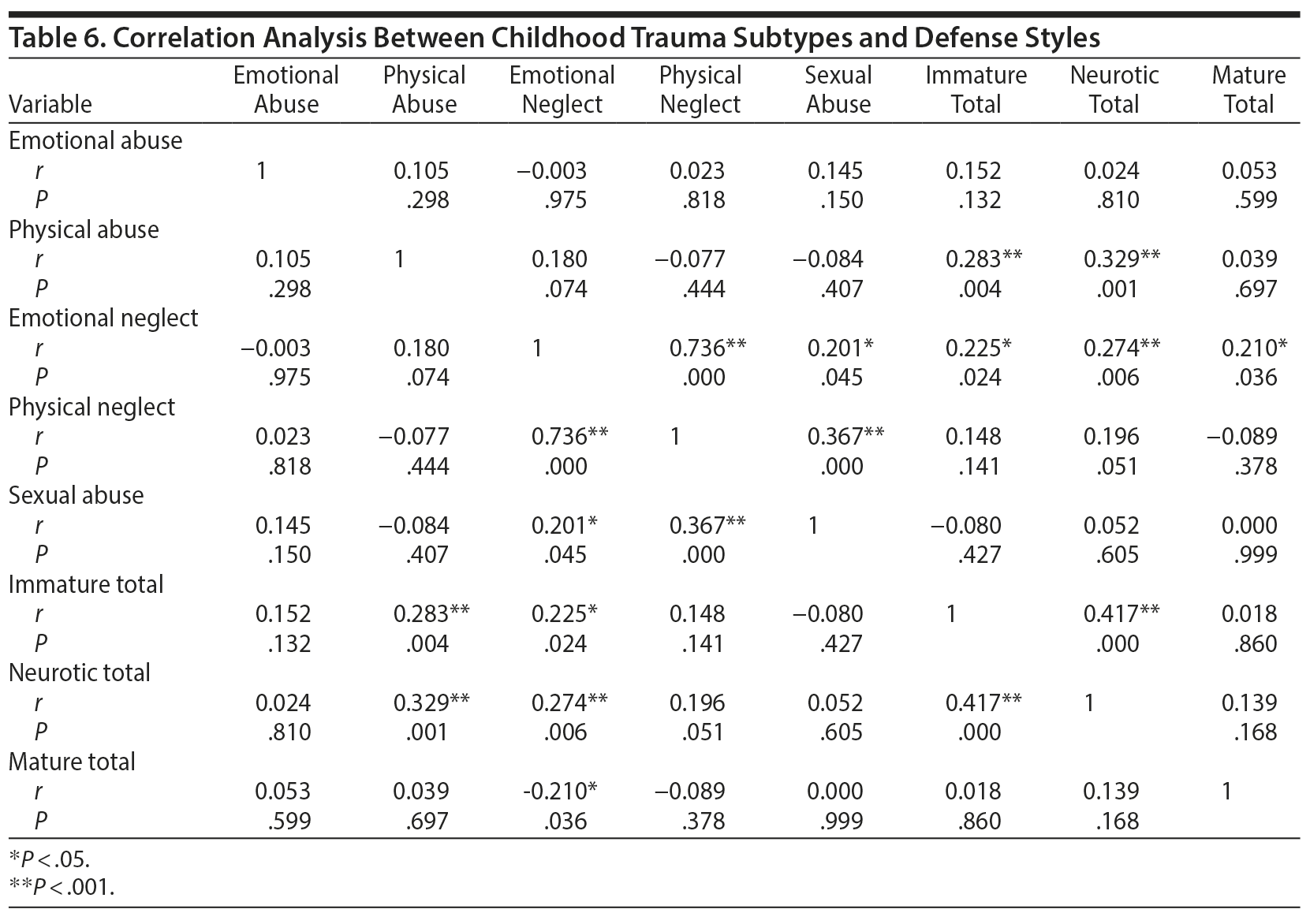Objective: Studies indicate that patients tend to develop chronic tension headache as a response to stress. The present study investigated the relationship between headache and the events that caused childhood traumas and defense styles, which could be considered as a significant source of stress in individuals with tension headache.
Methods: Fifty patients between the ages of 18 and 65 years diagnosed with tension headache were included in the present study. The control group included 50 healthy participants. All study participants completed a sociodemographic data form prepared by the researchers and the Childhood Trauma Questionnaire and Defense Style Questionnaire.
Results: Traumatic experiences (emotional abuse, physical abuse, emotional neglect, physical neglect, and sexual abuse) were significantly higher in the patient group compared to the control group. The total score of immature and neurotic defense styles was higher in the patient group than in the control group (P < .001, P < .001). The mature defense styles total score was significantly higher in the control group than in the patient group (P = .006). A positive correlation was found between the childhood trauma scores and immature and neurotic defense style scores.
Conclusion: The findings indicate that traumatic experiences during childhood were more frequent in patients with tension headache compared to healthy individuals. Furthermore, these individuals had difficulty coping with stress, and inappropriate defense styles were employed as a response to stress.
Analysis of Childhood Traumas and Defense Styles in Patients With Tension Headache
ABSTRACT
Objective: Studies indicate that patients tend to develop chronic tension headache as a response to stress. The present study investigated the relationship between headache and the events that caused childhood traumas and defense styles, which could be considered as a significant source of stress in individuals with tension headache.
Methods: Fifty patients between the ages of 18 and 65 years diagnosed with tension headache were included in the present study. The control group included 50 healthy participants. All study participants completed a sociodemographic data form prepared by the researchers and the Childhood Trauma Questionnaire and Defense Style Questionnaire.
Results: Traumatic experiences (emotional abuse, physical abuse, emotional neglect, physical neglect, and sexual abuse) were significantly higher in the patient group compared to the control group. The total score of immature and neurotic defense styles was higher in the patient group than in the control group (P < .001, P < .001). The mature defense styles total score was significantly higher in the control group than in the patient group (P = .006). A positive correlation was found between the childhood trauma scores and immature and neurotic defense style scores.
Conclusion: The findings indicate that traumatic experiences during childhood were more frequent in patients with tension headache compared to healthy individuals. Furthermore, these individuals had difficulty coping with stress, and inappropriate defense styles were employed as a response to stress.
Prim Care Companion CNS Disord 2020;22(5):20m02592
To cite: Korkmaz S, Kazgan A , Yıldız S, et al. Analysis of childhood traumas and defense styles in patients with tension headache. Prim Care Companion CNS Disord. 2020;22(5):20m02592.
To share: https://doi.org/10.4088/PCC.20m02592
© Copyright 2020 Physicians Postgraduate Press, Inc.
aDepartment of Psychiatry, Firat University Faculty of Medicine, Elazig, Turkey
bDepartment of Neurology, Firat University Faculty of Medicine, Elazig, Turkey
cDepartment of Ä°nternal Medicine, Firat University Faculty of Medicine, Elazig, Turkey
*Corresponding author: Sevda Korkmaz, MD, Department of Psychiatry, Firat University Faculty of Medicine, Elazig, Turkey ([email protected]).
The driving force behind psychosomatic disorders cannot be fully explained. However, it is acknowledged that traumas and significant life events experienced by individuals are the main cause of the onset of such disorders.1
Tension headache is a psychosomatic disorder that represents a significant percentage of primary headaches. Myofascial mechanisms have been shown to play an important role in the pathophysiology of the disorder.2 Patients with tension headache were found to have a decrease in the function of antinociceptive systems that control the perception of pain and facilitation in the neurons that cause pain perception in the brain stem due to various stimuli, especially psychosocial stress factors.3 It is acknowledged that the systems of stress intervention are disrupted in children who encounter traumatic experiences at early ages.4 Due to such traumatic events, the individual starts to use his/her defense styles unconsciously to relieve emotions such as anxiety, guilt, sadness, and embarrassment.
On the basis of clinical observations, we have found that previous traumatic experiences are more common in patients with tension headache compared to healthy individuals. Furthermore, we have also noted that patients with tension headache exhibit differences in several defense styles, which are employed due to life events. Therefore, the objective of the present study was to investigate whether traumatic experiences contribute to the onset of tension headache and to identify the defense styles that are more frequently used by these patients.
METHODS
In this cross-sectional study, standardized scales were used to analyze the psychological defense styles and traumatic experiences of patients with tension headache compared to healthy controls. Local ethics committee approval was obtained, and the study was conducted in accordance with the Helsinki Declaration.5
Fifty patients aged 18 to 65 years diagnosed with tension headache in the Neurology Outpatient Clinic of Fırat University Faculty of Medicine, Elazig, Turkey, were included in the study. Individuals with a neurologic disorder were excluded from the study based on neurologic examination, as their conditions could lead to cognitive dysfunction. Patients unable to complete questionnaires and scales due to physical and mental disorders and those who were illiterate were also excluded. The control group comprised 50 healthy hospital staff members aged 18 to 65 years who met the same inclusion/exclusion criteria and had similar sociodemographic characteristics as the patient group.
The participants in the patient and control groups completed the sociodemographic data form prepared by the researchers, the Childhood Trauma Questionnaire,6,7 and the Defense Style Questionnaire.8 Furthermore, participants in the patient group were asked to indicate the severity of their headache through the Visual Analog Scale for Pain.9
Statistical Analysis
SPSS version 22 (IBM, Armonk, New York) was used for statistical analyses. Normal distributions were tested with the Kolmogorov-Smirnov test with Lilliefors correction. Student t test was used for comparisons between groups when the data exhibited normal distribution, and Mann-Whitney U test was used when the data was not normally distributed. Pearson correlation analysis was used to determine the positive or negative relationships between results, and P < .05 was considered statistically significant.

- The cause of psychosomatic disorders cannot fully be explained.
- Traumatic experiences during childhood were more frequent in patients with tension headache compared to healthy individuals.
- A positive correlation was determined between childhood trauma scores and immature and neurotic defense styles scores.
Childhood Trauma Questionnaire. The Childhood Trauma Questionnaire, developed by Bernstein et al,6 originally included 70 items but later was reduced to 28.7 The 5-point Likert-type self-report scale, which evaluates violence during childhood, focuses on 5 factors: physical abuse, sexual abuse, emotional abuse, physical neglect, and emotional neglect. The categorical evaluation of the scale based on the total score of 5 factors was conducted by Walker et al.10 The participants’ responses indicating “sometimes, often true, very often true” were coded categorically and included in the abuse/neglect group in the present study.11
Defense Style Questionnaire. The 40-item Defense Style Questionnaire is a self-report instrument designed to measure the reflections of the unconsciously used defense styles on consciousness and consists of 40 items and 20 defenses. The scale, developed by Andrews et al,8 evaluates each item on a 9-point Likert-type scale, wherein 1 corresponds to strongly disagree and 9 to strongly agree. The 20 defense mechanisms of the scale were classified under 3 main dimensions: immature, neurotic, and mature defenses. It is possible to use a total score or arithmetic mean for measuring each of the subdefenses and the 3 defense styles. Immature defenses include reflection (questions 6 and 29), passive aggression (questions 23 and 36), acting out (questions 11 and 20), isolation (questions 34 and 37), devaluation (questions 10 and 13), autistic fantasy (questions 14 and 17), denial (questions 8 and 18), displacement (questions 31 and 33), dissociation (questions 9 and 15), splitting (questions 19 and 22), rationalization (questions 4 and 16), and somatization (questions 12 and 27). Neurotic defenses include doing-undoing (questions 32 and 40), pseudoaltruism (questions 1 and 39), idealization (questions 21 and 24), and reaction formation (questions 7 and 28). Mature defenses include sublimation (questions 3 and 38), humor (questions 5 and 26), suppression (questions 2 and 25), and anticipation (questions 30 and 35). A validity and reliability study of the scale was conducted in the Turkish language by Yilmaz et al.12
RESULTS
The mean age of participants in the patient and control groups was 35.6 ± 8.8 and 33.3 ± 8.53, respectively. The sociodemographic data of both groups are presented in Table 1. Traumatic experiences (emotional abuse, physical abuse, emotional neglect, physical neglect, and sexual abuse) were found to be significantly higher in the patient group compared to the control group (P = .019, P = .024, P = .000, P = .001, P = .045, respectively; Table 2). The total scores of immature and neurotic defense styles were found to be statistically higher in the patient group than in the control group (P < .001 and P < .001, respectively). The total score of mature defense styles was significantly higher in the control group than in the patient group (P = .004, Table 2). There was a statistically significant difference between the patient and control groups based on the subdefense scores for acting out, isolation, autistic fantasy, displacement, splitting, and somatization within immature defense styles (Table 3). A statistically significant difference was determined between the patient and control groups based on the subdefense scores for doing-undoing, pseudoaltruism, and reaction formation within the neurotic defenses (Table 4). The subdefense scores for sublimation and suppression, which are mature defense styles, were statistically significantly different for the patient and control groups (Table 5). A positive correlation was determined between the childhood trauma scores and immature and neurotic defense style scores (Table 6).
DISCUSSION
The present study identified traumatic experiences (emotional abuse, physical abuse, emotional neglect, physical neglect, and sexual abuse) as significantly higher in the patient group with tension headache compared to the control group. Total scores of immature and neurotic defense styles were higher in the patient group, while the total score of mature defense styles was higher in the control group. There was also a positive relationship between childhood trauma scores and immature and neurotic defense style scores.
Psychological traumas experienced during childhood are physical abuse, sexual abuse, emotional abuse, emotional neglect, and physical neglect. Furthermore, negative events in life, such as accidents and natural disasters, are also considered psychological traumas.13 The biological stress response system becomes active through a primary mechanism created in the brain when the trauma occurs due to these stress factors. The hypothalamic-pituitary-adrenal axis, responsible for regulating the body’s stress response, becomes disrupted.14 Furthermore, the stressors experienced in the early stages of life could change the main neural networks and functions in a developing brain.15-17 It is acknowledged that severe stress and negative childhood experiences are associated with psychiatric disorders and several psychosomatic disorders such as obesity, chronic fatigue syndrome, and fibromyalgia.18-20
Studies21,22 have indicated that there is a strong relationship between childhood traumas and somatization or somatoform disorders during adulthood and that the relationship between such traumas and pain is prevalent in women. The causes of the relationship between traumas and somatic symptoms are unclear, yet somatization plays a major role in the onset and progress of pain in the body. Somatization is considered the expression of stress or a direct way of representing traumatic stress in several cultures and subcultures.23 Particularly, nervous individuals who experience difficulty expressing their emotions and have an anxious personality might apply this mechanism more frequently.24,25 Individuals who are prone to stress experience difficulty in expressing their emotions verbally. In patients with tension headache, the increased anger due to psychological or somatic factors cannot be externally reflected, therefore introverted anger increases and, consequently, headache levels increase through somatization.26 Such issues are more common in individuals who usually avoid talking about their problems or were raised in families in which anxiety was suppressed. Under such conditions, the individual’s stress is expressed through the body, and the problem is perceived to be physical.
The present study established that the total scores for immature and neurotic defense styles were higher in the patient group and the total score for mature defense styles was higher in the control group. Defense styles have been classified by several psychologists and range from mature defenses to immature defenses.27 Immature defense styles are the most primitive mechanisms that may be observed during early life, and neurotic defense styles are frequently used by individuals with obsessive-compulsive disorder, by those with a hysterical nature, or by individuals who are under stress. Mature defense mechanisms are classified as those that enable individuals to establish a harmonious and positive balance between their inherent dynamics and environmental reality. Therefore, it is acknowledged that the use of mature defenses refers to a personality with healthy functioning, and the use of immature defenses refers to psychopathology.28,29
Personality changes occur as a result of the disruption in object relations due to traumatic events during the process of individuation, and a pattern that utilizes neurotic defenses frequently occurs.30 A previous study31 found a positive and significant relationship between childhood traumas and immature and neurotic defense styles and a negative and significant relationship between childhood traumas and mature defense styles. The present study also found a positive relationship between childhood trauma scores and immature and neurotic defense style scores.
Emotions such as despair are highly common in patients with tension headache who experience chronic pain. Such patients develop a self-pattern with limited ability to cope with problems as a result of the traumatic events in their past coupled with a feeling of despair.32 Use of appropriate defense mechanisms and more constructive problem-solving coping mechanisms once the problems are encountered could help reduce anxiety in such patients. Tension headache is a chronic disorder that challenges medical practitioners and results in economic losses due to the required examinations and frequent hospital admissions, similar to several other psychosomatic disorders. Therefore, it is essential to provide patients with tension headache appropriate treatment strategies as well as psychological support and assistance that reinforces the treatment.
This study had several limitations. The sample size of the patient group was relatively small, and several participants in the patient group experienced more than 1 type of trauma, therefore, it was not possible to measure the relationships between the trauma types and symptoms. Furthermore, the scales used in the study were self-report scales. Individuals who experience difficulty or embarrassment in expressing themselves in terms of sharing their traumas could have avoided several negative experiences that were highly intense and distressing.
Submitted: January 13, 2020; accepted April 26, 2020.
Published online: August 27, 2020.
Potential conflicts of interest: None.
Funding/support: None.
REFERENCES
1. Beutel TF, Zwerenz R, Michal M. Retrospectively reported childhood trauma and health behavior in adult psychosomatic patients [in German]. Z Psychosom Med Psychother. 2016;62(4):306-321. PubMed
2. Coskun O. Tension type headache and treatment. J Neurol Special Topics. 2008;1(1):22-26.
3. Fields HL, Basbaum AI. Central nervous system mechanisms of pain modulation. In: Wall PD, Melzack RD, eds. Textbook of Pain. 3rd ed. Edinburgh: Churchill Livingstone; 1994:243-257.
4. Cicchetti D, Rogosch FA, Gunnar MR, et al. The differential impacts of early physical and sexual abuse and internalizing problems on daytime cortisol rhythm in school-aged children. Child Dev. 2010;81(1):252-269. PubMed CrossRef
5. Riis P. Perspectives on the fifth revision of the Declaration of Helsinki. JAMA. 2000;284(23):3045-3046. PubMed CrossRef
6. Bernstein DP, Fink L, Handelsman L, et al. Initial reliability and validity of a new retrospective measure of child abuse and neglect. Am J Psychiatry. 1994;151(8):1132-1136. PubMed CrossRef
7. Bernstein DP, Stein JA, Newcomb MD, et al. Development and validation of a brief screening version of the Childhood Trauma Questionnaire. Child Abuse Negl. 2003;27(2):169-190. PubMed CrossRef
8.Andrews G, Singh M, Bond M. The Defense Style Questionnaire. J Nerv Ment Dis. 1993;181(4):246-256. PubMed CrossRef
9.Miller MD, Ferris DG. Measurement of subjective phenomena in primary care research: the Visual Analogue Scale. Fam Pract Res J. 1993;13(1):15-24. PubMed
10.Walker EA, Unutzer J, Rutter C, et al. Costs of health care use by women HMO members with a history of childhood abuse and neglect. Arch Gen Psychiatry. 1999;56(7):609-613. PubMed CrossRef
11.Tyrka AR, Wyche MC, Kelly MM, et al. Childhood maltreatment and adult personality disorder symptoms: influence of maltreatment type. Psychiatry Res. 2009;165(3):281-287. PubMed CrossRef
12.Yilmaz N, Gençöz T, Ak M. Psychometric properties of the defense style questionnaire: a reliability and validity study [in Turkish]. Turk Psikiyatr Derg. 2007;18(3):244-253. PubMed
13.Bülbül F, Çakır Ü, Ülkü C, et al. Childhood trauma in recurrent and first episode depression. Anatolian Journal of Psychiatry. 2013;14(2):93–99. Anatolian Journal of Psychiatry. 2013;14(2):93-99. CrossRef
14.De Bellis MD, Zisk A. The biological effects of childhood trauma. Child Adolesc Psychiatr Clin N Am. 2014;23(2):185-222, vii. PubMed CrossRef
15.Hambrick EP, Brawner TW, Perry BD. Timing of early-life stress and the development of brain-related capacities. Front Behav Neurosci. 2019;13(13):183. PubMed CrossRef
16.Flügge G, van Kampen M, Meyer H, et al. Alpha2A and alpha2C-adrenoceptor regulation in the brain: alpha2A changes persist after chronic stress. Eur J Neurosci. 2003;17(5):917–928. PubMed CrossRef
17.Marusak HA, Martin KR, Etkin A, et al. Childhood trauma exposure disrupts the automatic regulation of emotional processing. Neuropsychopharmacology. 2015;40(5):1250-1258. PubMed CrossRef
18.Krzeczkowska A, Karatzias T, Dickson A. Pain in people with chronic fatigue syndrome/myalgic encephalomyelitis: the role of traumatic stress and coping strategies. Psychol Health Med. 2015;20(2):210-216. PubMed CrossRef
19.Mutlu H, Bilgiç V, Erten S, et al. Evaluation of the relationship between childhood traumas and adulthood obesity development. Ecol Food Nutr. 2016;55(4):390–401. Ecol Food Nutr. 2016;55(4):390-401. PubMed CrossRef
20.Roelofs K, Spinhoven P. Trauma and medically unexplained symptoms towards an integration of cognitive and neuro-biological accounts. Clin Psychol Rev. 2007;27(7):798-820. PubMed CrossRef
21.Brown J, Berenson K, Cohen P. Documented and self-reported child abuse and adult pain in a community sample. Clin J Pain. 2005;21(5):374-377. PubMed CrossRef
22.Walsh CA, Jamieson E, Macmillan H, et al. Child abuse and chronic pain in a community survey of women. J Interpers Violence. 2007;22(12):1536-1554. PubMed CrossRef
23.Kirmayer LJ, Robbins JM, Paris J. Somatoform disorders: personality and the social matrix of somatic distress. J Abnorm Psychol. 1994;103(1):125-136. PubMed CrossRef
24.Kalaydjian A, Merikangas K. Physical and mental comorbidity of headache in a nationally representative sample of US adults. Psychosom Med. 2008;70(7):773-780. PubMed CrossRef
25.Felbinger J, Reinisch VM, Sostak P, et al. Anxiety and depression in headache patients: the example of managed care of chronic headache patients in Bavaria [in German]. Schmerz. 2009;23(1):33-39. PubMed CrossRef
26.Öz O, Erdem M, Yücel M, et al. Evaluation of anger, anger expression style and mood profile in tension-type headache. Archies of Neuropsychiatry. 2011;48(3):171-174.
27.Vaillant GE. Adaptation to Life. Boston, MA: Harvard University Press; 1977.
28.Kohut H. Kendiliğin Çözümlenmesi [The Analysis of the Self]. Cem Atabaşoğlu, Banu Büyükkal, Cüneyt İşcan (Çev.). İstanbul, Turkey: Metis; 1971 (Özgün eser 2015).
29.Kernberg O. Sınır Durumlar ve Patolojik Narsisizm [Borderline Conditions and Pathological Narcissism]. 3.Baskı, Mustafa Atakay (Çev.). Istanbul, Turkey: Metis; 1975 (Özgün eser 2002).
30. Koptagel-Ilal G. Psikosomatik: Psikonevroz Psikosomatik Psikoterapi [Psychosomatic: Psychoneurosis Psychosomatic Psychotherapy]. Ankara, Turkey: AB Ofset; 2000:72–114.
31.Yönen EG. The relatıonshıp between chıldhood mental trauma and ego defense mechanısms. Social Economic Review. 2018;53(1):34–45.
32.Davidson MA, Tripp DA, Fabrigar LR, et al. Chronic pain assessment: a seven-factor model. Pain Res Manag. 2008;13(4):299-308. PubMed CrossRef
Please sign in or purchase this PDF for $40.00.
